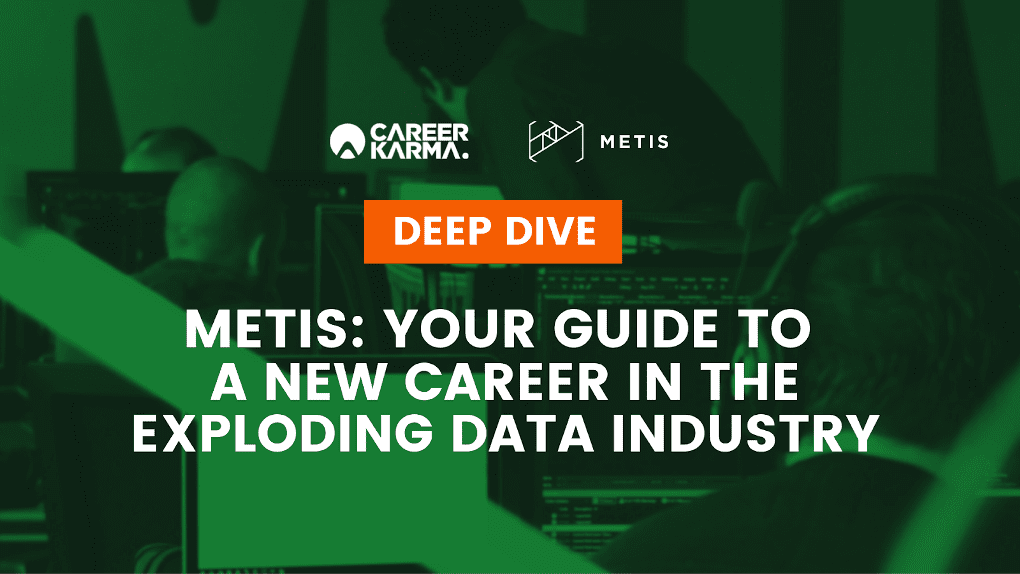Data plays a staggering role in our daily lives. Every minute, over 41 million messages are sent via WhatsApp, users stream 404,444 hours of video on Netflix, and consumers spend $1 million online. Companies are using consumer data to improve their outcomes and our experience every day.
Organizations everywhere are hiring more employees to extract, shape, analyze, interpret, and visualize that data to do everything from forecasting futures and risk management to designing new products and improving the user experience.
Bootcamps like Metis are helping people enter the booming data science and analytics industry with high-quality instruction aimed at helping students acquire the skills necessary to become true data professionals. But there are so many aspects to the data science field that it can be hard to get a sense of where you fit.
This guide will prepare you for studying data science and analytics by breaking down the key fields, and how these fields work via a real-world example. Each of these fields has a corresponding program at Metis, so if one seems like a great fit for you then there’s a bootcamp you can take to get started.
Let’s start with a hypothetical scenario. A cereal company that sources its wheat from Brazil comes to its data team with a new assignment. The company is thinking of developing new products due to a dip in the price of wheat. But to ensure these new products remain profitable, they ask their department to predict how long these low grain prices will last.
Here’s how each role in the data department would help tackle this problem.
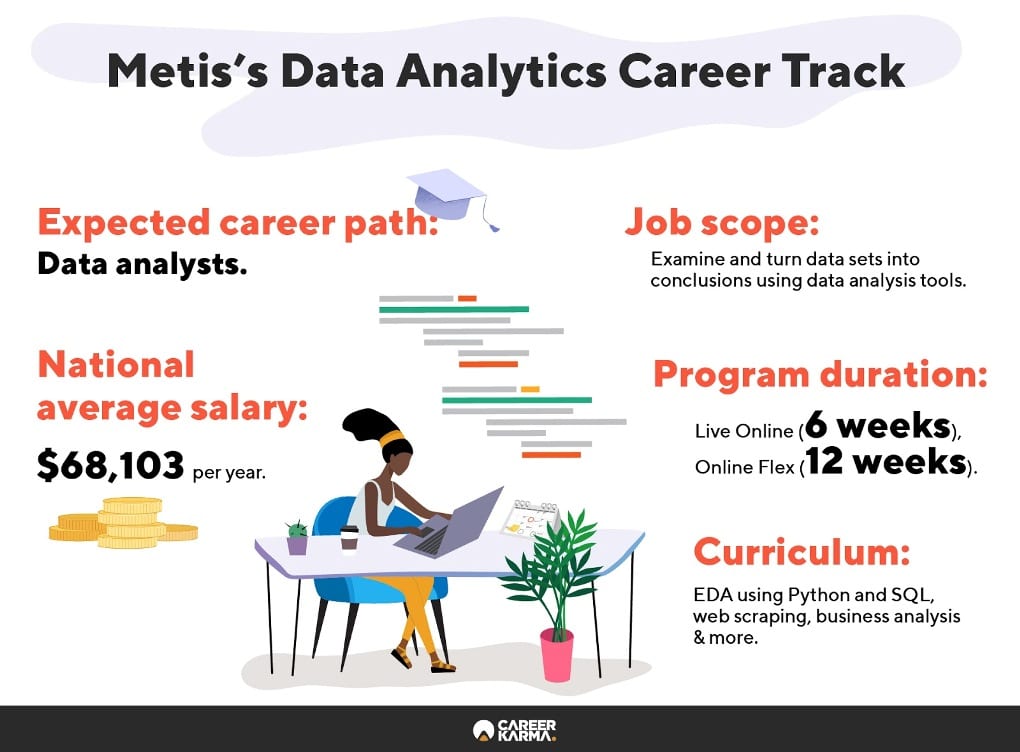
What Is Data Analytics?
Data analytics is a branch of data science where people turn data sets into conclusions that tell the story of a business’s past initiatives. As you can see from the example above, data analysts are an important part of any business that needs to look at the market to make decisions.
There are a couple of key steps to data analytics. Initial data analysis is where data analysts check assumptions about their previous models and ensure things are progressing as expected. After that initial analysis, you move on to exploratory data analysis (EDA).
In the example above, the data analysts in the cereal company’s data department would work to find out if there’s a pattern in the grain prices that the company can use to make a prediction. A data analyst could easily build a line plot of grain prices in Brazil over time to see if there’s a pattern in the data. They’d first perform EDA to make sense of the data set, then plot out the pattern and present it to the rest of the team.
At Metis, data analytics students learn to conduct exploratory data analysis with tools like Python and SQL, along with linear regression and web scraping over six weeks. Toward the end of the program, they will learn the fundamentals of business with data, including presentation skills, data ethics, creating dashboards, and project management skills.
As you’ll notice, the data analytics curriculum at Metis lays a foundation for some of the data science curriculum. Because Metis takes a modularized approach to its instruction, you can smoothly transition from data analytics to the data science program. Both programs offer primers in EDA, data visualization, and business fundamentals, but the data science bootcamp adds machine learning concepts to advance students to the next level.
If you’re interested in working as a data analyst, you’ll need some SQL skills, knowledge of some data visualization techniques, and it’s helpful to have programming experience. Though Metis does teach some programming skills at the beginning of the bootcamp, its Bootcamp Prep courses will fully prepare you for the road ahead.
The average data analyst makes $68,103 per year, according to Glassdoor. Though this role may earn less than a data scientist, you’ll be learning important skills that will inform your future career.
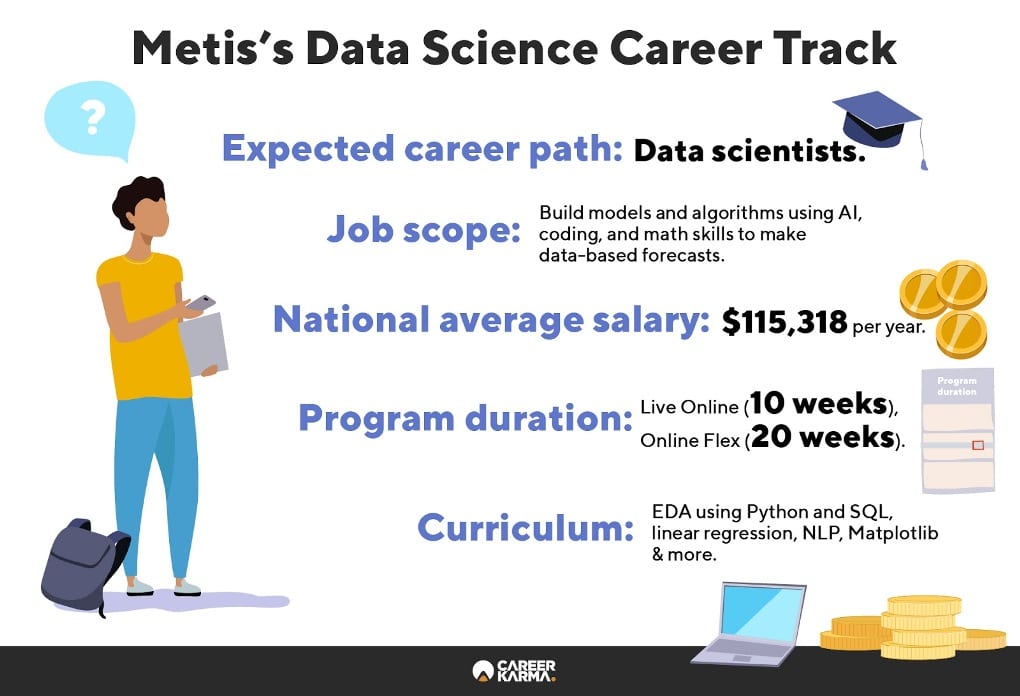
What Is Data Science?
Data science is a combination of multiple fields including data analytics, data engineering, and more that organizations use to make decisions about their past efforts and projections about their future.
Data scientists use artificial intelligence, programming, and mathematics to build models and algorithms that make quick forecasts based on past data. Data scientists then use these forecasts and their business acumen to present predictions to company executives. They work at the intersection of programming and business to give companies a steady footing for the future.
To continue the cereal company example, after the analyst presents the data to the rest of the team, the data scientist looks for a pattern in the falling grain prices. If there’s a pattern, a data scientist could build a model to predict if the prices will continue to fall, and for how long. They’d then present the model to the executives at the company so they can make an informed decision.
In Metis’s data science bootcamp, students learn concepts including EDA, linear regression, web scraping, business fundamentals for data practitioners, machine learning, natural language processing, unsupervised learning, and more.
As we mentioned above, one component of what data scientists do is look at the past performance of an organization or one of its initiatives and then use hard evidence to decide how it will perform in the future. For example, they’d plot past performance using a line chart, scatter plot, or heat map as part of EDA, and then use linear regression to predict the performance of a variable that affects an organization based on the information you have.
If you’re interested in becoming a data scientist, you’ll need strong programming, math, communication, critical thinking, and problem-solving skills. You’ll also need strong business acumen to properly communicate the effects that decisions may have on a company’s future based on the data.
Metis recommends that data science applicants familiarize themselves with SQL, data visualization, and have a bit more advanced programming skills. Applicants should also have a good understanding of how data analysis and data science play a role in the business, and a creative mind to think of uncommon solutions.
The average data scientist makes $115,318 per year, according to Glassdoor.
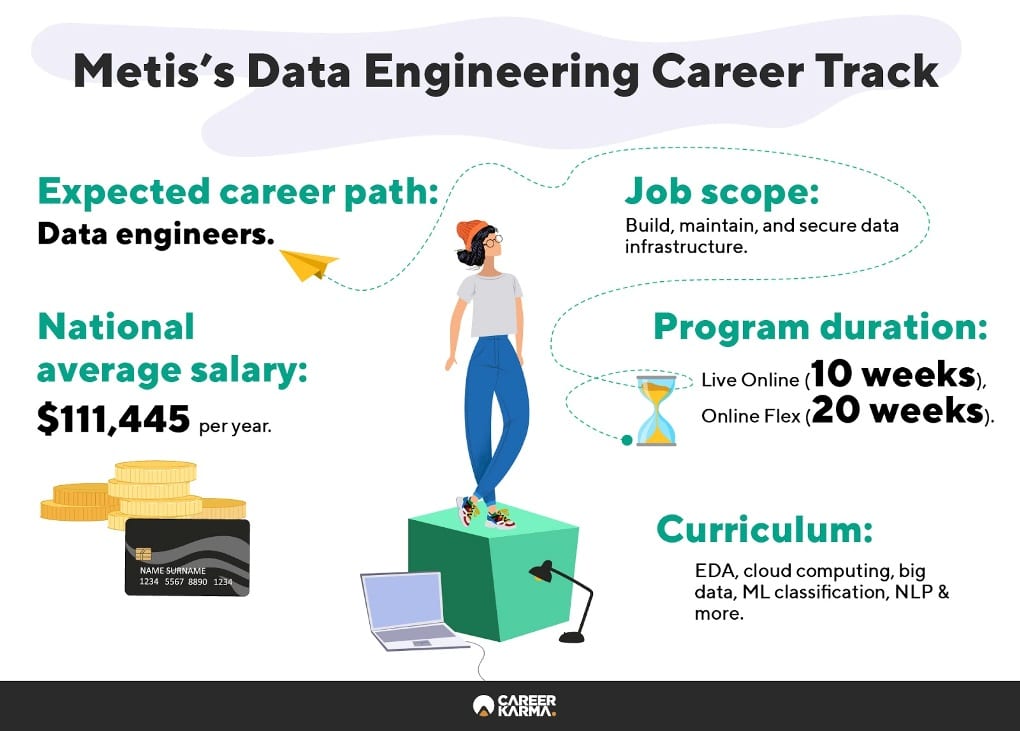
What Is Data Engineering?
Data engineers work to make data as accessible as possible for data scientists and analysts. They do this by focusing on cleaning data sets and securing their pipelines.
Data pipelines are the routes that data follows as it enters a system. A data engineer builds the algorithms and models that automatically clean and sort data before sending it to its most fitting destination. These pipelines transform data through this process by taking it from raw and unsorted data lakes into clean and organized data warehouses.
To go back to the cereal company example, the data analysts who investigate the past prices of grain in Brazil don’t have to meticulously research to hunt down the information. The data engineering team’s pipelines automatically catalog the price of every grain purchase that the company has ever made. So the analysts simply have to search the database with the right terms to quickly find the prices they need.
Data science and engineering students at Metis learn machine learning skills that will help them build the pipelines that the rest of the data team relies on.
Because of the data engineer’s hard work at the beginning of the chain, data analysts can easily find the data they’re looking for in the data warehouse. The analysts can then plot out that data when necessary, as the data scientist’s machine learning constructions automatically use the data to create forecasts.
The average data engineer makes $111,445 per year, according to Glassdoor. This salary reflects the hard work that they do to set up the rest of the data team for success. You have to be a really strong programmer to work in this field.
If you’ve been working as a data analyst for a while and you’re looking to advance your career, you basically have two paths you can take. If you prefer the technical programming side of the job, you might prefer to be a data engineer. If you prefer the more communicative and business-heavy side of the job, then you may prefer working as a data scientist.
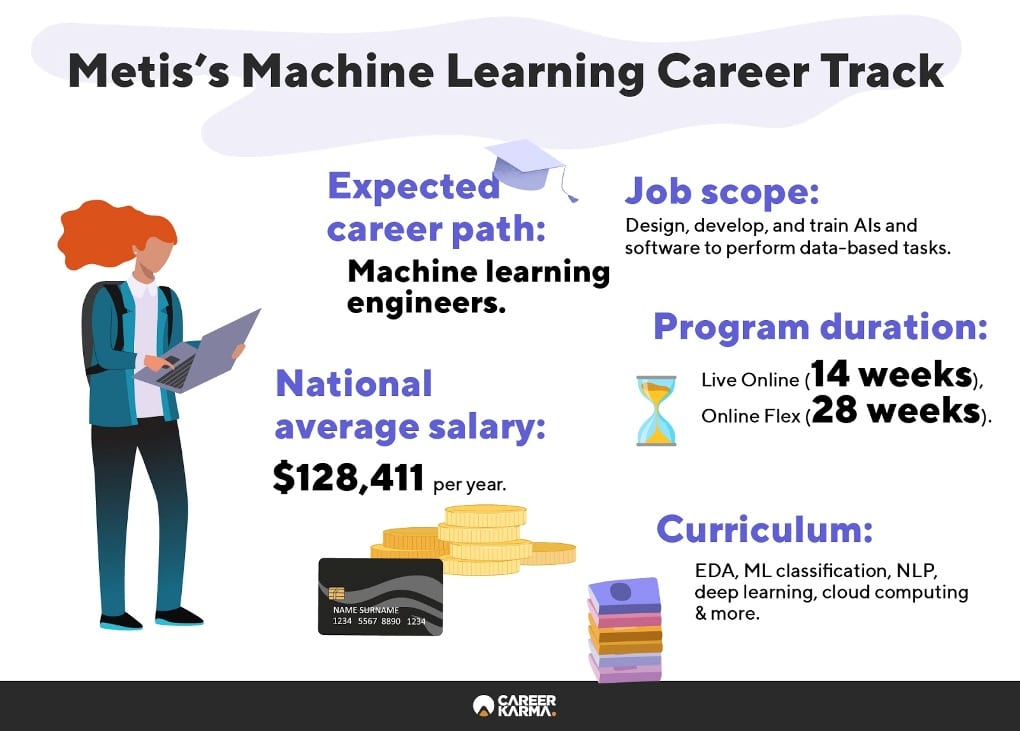
What Is Machine Learning?
Machine learning is a branch of artificial intelligence where computers improve their own functions over time by analyzing some sort of input. This process can be supervised or unsupervised, but machine learning algorithms have a wide range of use in plenty of industries.
These algorithms spot potential fraud at your bank, predict the future of the stock market, help doctors diagnose diseases, and more.
The data scientists and engineers at the cereal company both use machine learning tools to make their jobs easier. The data scientist uses machine learning to help predict the future of the market as precisely as possible based on past data. The data engineer uses machine learning to automatically sort all of the data that the company produces, including the grain prices.
At Metis, data science and machine learning students learn about the basics of classification before diving into natural language processing and unsupervised learning. After this, they dive into deep learning and data engineering.
Deep learning is a more intensive branch of machine learning, where engineers construct systems that work much like the human brain for advanced tasks. These networks can have several constructions, but at Metis, you’ll learn about neural networks.
Deep learning is a branch of machine learning where the model can train itself and transfer pre-formed conclusions about similar data to completely new data sets. You’ll learn about transfer learning, embeddings, and convolutional neural networks as you progress through the program.
Machine learning allows data engineers to sort data as efficiently and quickly as possible. Sorting that data by hand would take hundreds of people so much time that when the data was available, it’d be out of date. Machine learning speeds up the process so that companies can provide a better experience for themselves and their customers as quickly as possible.
As we mentioned above, data engineers and data scientists both use machine learning to make their jobs easier. The average machine learning engineer makes $128,411 per year, according to Glassdoor.
Metis’s machine learning bootcamp is its most advanced and comprehensive program, designed to round out engineers with a business background.
Metis alumni most commonly find jobs as data scientists, data analysts, or data engineers. Now that you have a sense of each role you may learn at Metis, here’s how Metis will bring you into the fields.
Entering Data Science & Analytics With the Metis Bootcamp Curriculum
Metis prepares people for the data science and analytics field with tools we’ve mentioned like Python and its frameworks, along with other tools like SQL, Hadoop, Spark, Tableau, and more. These tools all form the foundation of your experience at Metis, which builds on itself as your knowledge advances.
Metis Bootcamp Prep
If you’re thinking of applying for Metis, but you have no experience whatsoever in programming or data, the school offers affordable prep courses to get you started.
The first Bootcamp Prep course is the Beginner Python and Math for Data Science class. This course teaches students the absolute basics of Python and the math concepts they’ll need to succeed in any Metis program. From there, students are ready to enter the data analytics bootcamp and start their journey.
If students have data analytics experience and want a gentle introduction to the data science bootcamp, they can take the Introduction to Data Science course. This course gives students a primer on the machine learning and coding concepts that they’ll study in the data science bootcamps.
Though these courses aren’t required for you to apply to Metis, they give you two advantages. They prepare you for the technical portion of the application process, and they also give you a foundation for the full program that will help you grasp the materials more easily.
The Metis Bootcamps
We’ve already discussed the data science and analytics bootcamps at Metis, but each of them offers unique value in its own way. The instructors who teach the bootcamps designed them with a mix of theory and practical application. The instructors also regularly take feedback from hiring partners and alumni to shape the curriculum based on the current market needs.
Students learn in a project-based curriculum that simulates a real-world job experience. You’ll learn how to identify the question that needs to be answered from the data, how to access and clean the data, and then how to visualize it to provide an insight to the end-user. After doing this multiple times in the program of your choice, you’ll be ready for anything a real job will ask of you.
Each bootcamp also offers two different structures to best fit your needs and schedule. You can take the live online bootcamp if you’re looking for a full-time intensive and structured program, or the flex program if you need more flexibility with your schedule while you’re looking to build a new future.
But the curriculum is only part of the story.
Metis Career Support
Metis’s Career Advisors work with students to ensure that they can properly launch their data science careers. These advisors have years of experience working with students individually to provide custom support and help them get hired in the field.
Students in the program have access to asynchronous workshops that help them prepare their job materials for their new data science careers. Students learn how to prepare their resumes and LinkedIn, while also getting ready to find jobs and negotiate their salaries.
Graduates participate in Metis’s Careers Week immediately after finishing the program, where they attend a series of live online workshops that dive into topics including networking, interviewing, and having an effective job search. They can also attend career advisor office hours, practice their technical interviewing, hear from hiring data professionals, and more.
Combine this support with help from Metis’s robust alumni network and access to an alumni-only Slack channel and resources folder, and you can see why Metis has been a benchmark for success in the data science field for so long.
Finding the Right Career Training with Metis
As we’ve mentioned, Metis has four main bootcamps that train people to work in data science, data analytics, data engineering, and machine learning. Now that you’ve learned about the earning power in each field and if they’re a fit for you at your data science skill level, you should be able to make an informed decision about which field is best for you.
If you’d like to get a sense of what you can expect from Metis’ bootcamps, feel free to watch its instructors in action through one of its on-demand workshop videos.
About us: Career Karma is a platform designed to help job seekers find, research, and connect with job training programs to advance their careers. Learn about the CK publication.
